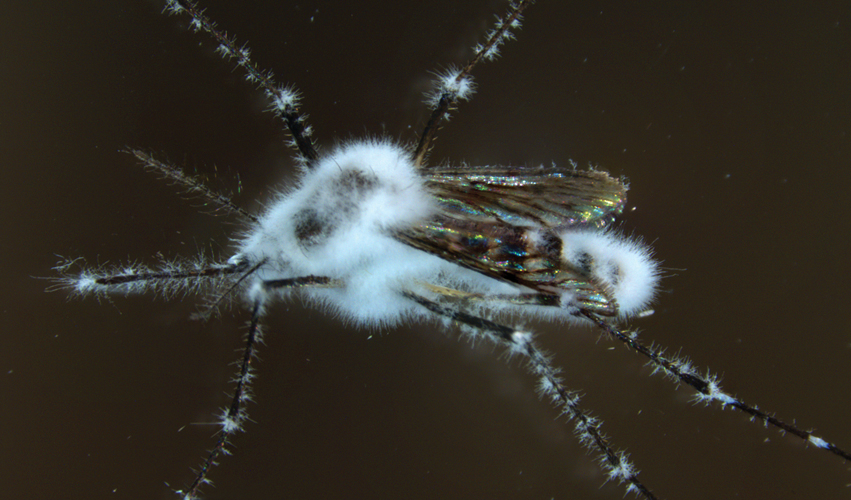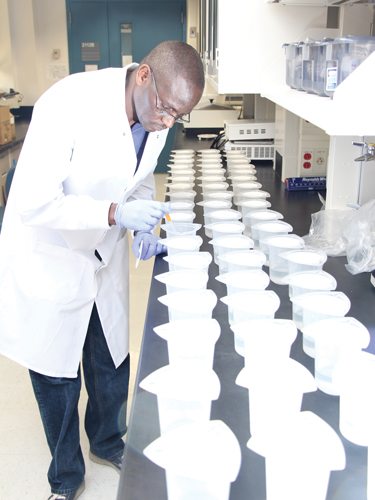
Fighting mosquitoes with new, eco-friendly, bio-based products…
Mosquitoes are rightfully considered among the most lethal animals in the world. It is estimated that more than one million people succumb to mosquito-borne diseases each year throughout the world. However, among the estimated 3,000 mosquito species described to date, only a small fraction are considered to be vectors of economic and public health significance, spreading diseases such as Zika, dengue, chikungunya, West Nile virus and malaria.
Defining the Problem
The United States is home to about 200 mosquito species, including about 60 species that reside in Illinois. Not all mosquito species transmit human pathogens—and of the 60 species residing in Illinois, three are the most important: the northern house Culex pipiens, responsible for transmission of the West Nile virus; the Asian tiger mosquito Ae. albopictus, a potential vector of dengue, Zika and other viruses; and the eastern tree hole mosquito Ae. triseriatus, responsible for transmission of La Crosse virus.
Although the greatest burden of mosquito-borne illnesses occur in the least-developed countries in the tropics, a number of mosquito-borne diseases have emerged in places with no previous history of activity—and re-emerged in regions where they had previously been controlled or eradicated. The recent epidemics of West Nile virus in North America, Zika virus in South America, and dengue virus in Asia and Central and South America provide a clear indication that mosquito-borne diseases have little respect for geographic boundaries or socio-economic status.
A recent report by the Centers for Disease Control and Prevention has shown that the number of arthropod-borne illnesses in the United States has tripled in the last 12 years. In Illinois, it has jumped from 226 cases in 2004 to 772 cases in 2016.
The most common practice for controlling mosquitoes is the use of synthetic insecticides. While this strategy has helped avert thousands of deaths due to mosquito-borne illnesses, there are concerns about the impact of synthetic insecticides on the environment and human health. Persistent use of these insecticides also creates intensive pressure for mosquitoes to develop resistance. These challenges have provided the impetus to discover and develop alternative tools for mosquito control.
To combat the resurgence of mosquito-borne diseases such as dengue or halt the spread of new pathogens such as Zika, entomologists with the USDA’s Agricultural Research Service in Peoria, Illinois, are developing alternative methods of control by employing environmentally-friendly compounds derived from plants or microbes.
Plant-Based Compounds
One of these approaches uses compounds isolated from plants to deter or kill mosquitoes. Unlike animals, plants cannot move from one place to another to escape the dangers posed by plant-eaters such as insects. Instead, they use other forms of defenses—one of which involves the production of chemical compounds that act as repellents, feeding deterrents, toxins and growth regulators to plant-eating insects. Many of these chemicals are also effective against mosquitoes and other biting insects.
USDA researchers in Peoria are testing a variety of plant chemicals that are toxic to mosquitoes. So far, we have identified some plant essential oils and associated chemicals that are lethal to mosquito eggs and larvae, as well as adults. While these essential oils kill at much higher concentrations than synthetic insecticides, they are safe to humans and the environment—and are even commercially applied in the food processing, cosmetics, pharmaceutical and textile industries, due to their safety and diverse biological activity. They also contain a mixture of chemical compounds that make them less amenable to resistance development by mosquitoes. Our long-term goal in this research is to develop a plant-based biopesticide that can supplement existing methods of mosquito control.
Insect-Killing Fungi
A second approach utilizes fungi that have evolved to specifically kill insects. This set of fungi, called entomopathogenic fungi due to their ability to decimate insects, have discovered an intricate way to overcome the insect defenses. As a spore, given the right conditions, they can survive for a period of time until they encounter a suitable host. In a fashion similar to a germinating seed, the fungal spore grows and penetrates the mosquito body, multiplying and releasing compounds that mask its presence inside the mosquito. The entomopathogenic fungi does not kill the mosquito right away, but instead makes it a zombie-like creature—less able to feed, reproduce and transmit pathogens.
Not all entomopathogenic fungi attack their mosquito hosts in the same fashion. Entomologists at USDA in Peoria are testing a panel of fungal species to determine the best candidates that are effective at killing mosquitoes, but safe to other insects such as bees and butterflies. So far, they have identified a series of fungal entomopathogens that show great promise in significantly reducing mosquito survival. In addition, they are working to identify the biological compounds used by the fungi to overcome the mosquito defenses in an effort to develop bio-based molecules that specifically target the mosquito vector and the viruses they transmit.
Furthermore, research in these two areas conducted at USDA in Peoria are also providing new knowledge in mosquito biology that would allow us to improve or generate novel tools to control mosquitoes and halt the spread of vectored human pathogens. iBi
The National Center for Agricultural Utilization Research in Peoria, Illinois, is among the largest agricultural research centers in the United States. NCAUR employs approximately 250 scientists and support staff in research to improve agricultural production, food safety and public health, economic development, and environmental quality.

